AMD’s Radeon HD 5450: The Next Step In HTPC Video Cards
by Ryan Smith on February 4, 2010 12:00 AM EST- Posted in
- GPUs
The Almost Perfect HTPC Card
When AMD told us that the Radeon 5000 series would offer bitstreaming audio support, our first thought was “this will make an excellent HTPC card.” Unfortunately since AMD started the launch at the high-end, we’ve had to wait some time for bitstreaming audio to cascade down to the passive cards best suited for an HTPC. With the launch of the 5450, that has finally come to fruition.
This in turn has lead us to reexamine the HTPC situation in order to see if the 5450 is really powerful enough for video-only HTPCs. While the Radeon 4350 and 4550 raised the bar for HTPC cards by offering 8-channel LPCM audio, problems ultimately surfaced with their video capabilities. Since deinterlacing and other AVIVO post-processing actions are done by the shader hardware, the limited shading capabilities of these cards meant that AMD couldn’t offer the full suite of AVIVO abilities at once. It was still enough to get perfect scores on the HD HQV test, but these deficiencies became apparently under the wrong situations.
The chief complaint here was that AMD’s best and most computationally intensive deinterlacing mode - Vector Adaptive Deinterlacing - wasn’t always made available for HD resolution video. This has waffled back and forth depending on the driver version, but right now AMD’s drivers lock out this feature (and most of the other AVIVO features) if Smooth Video Playback is enabled. So 4350/4550 owners had to choose between VA and other features without being able to have it all.

AVIVO Control Panel
When doing the research for this review we came across these complaints, and also a very interesting test for the issue: a specially crafted heavily interlaced 1080i MPEG-2 file called Cheese Slices, made by blaubart of the AV Science Forum. Cheese Slices is what amounts to an stress test that has more noise and interlacing artifacts in it than any real video would have, and is more than deinterlacers today can handle. It’s an unfair test – but that’s by design – as it does a very good job of highlighting when Vector Adaptive Deinterlacing is in use. With Cheese Slices, we can easily tell if Vector Adaptive mode is being used, or a lesser mode like Motion Adaptive is in use by what happens to the angled lines inside the geometric figures. Smooth lines are Vector Adaptive deinterlaced, jagged lines are deinterlaced with a lesser mode.
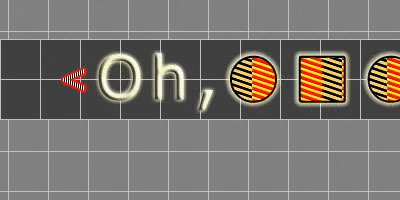
Reference quality: non-interlaced
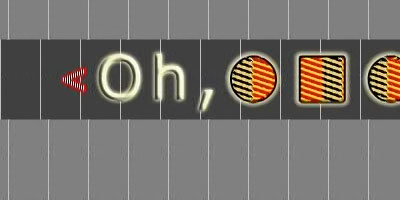
Radeon 5670 Deinterlacing
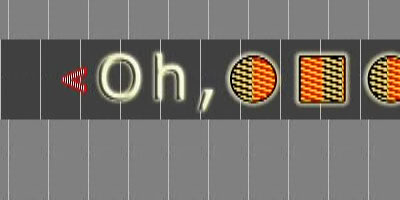
Radeon 5450 Deinterlacing
For the sake of reference, the Radeon 5670 and higher pass this test. Cards at that performance level have more than enough shader power to process all of the AVIVO effects and provide Vector Adaptive Deinterlacing at the same time, and this is the same case for the 4600 series. The 4550 on the other hand fails this test so long as Smooth Video Playback is enabled, as it’s outright disabling Vector Adaptive Deinterlacing.
As for the 5450, the results aren’t quite what we were hoping for. AMD believes that the 5450 is powerful enough that they allow it to use all of the AVIVO processing features at once, which means the drivers allow us to turn on things like Vector Adaptive Deinterlacing and denoising even when Smooth Video Playback is enabled. However in our tests with Smooth Video Playback enabled, Vector Adaptive Deinterlacing isn’t used even when we force it through the drivers. Everything else works with Smooth Video Playback enabled, just not Vector Adaptive Deinterlacing. If we disable Smooth Video Playback, then Vector Adaptive Deinterlacing will kick in.
We’ve informed AMD of our findings, and they’re still looking in to the issue. However we believe that the problem is ultimately a lack of resources on the 5450 to handle all of this, so we’ll see what they come up with.
It also wouldn’t be fair on our part to harp on this too much, as by no means is the 5450 a bad HTPC card. Everything else works correctly and AMD’s Motion Adaptive mode is quite good. In fact the only practical reason that Vector Adaptive mode matters is that it handles one thing better than Motion Adaptive: angled lines. The lines on sports fields suffer badly from interlacing artifacts, and Motion Adaptive mode can’t completely reconstruct them correctly; you need Vector Adaptive to accomplish this. So the only issue with the 5450 as an HTPC card is that it’s not a great choice for watching sports on a large TV where Motion Adaptive Deinterlacing would result in jagged lines on the field.
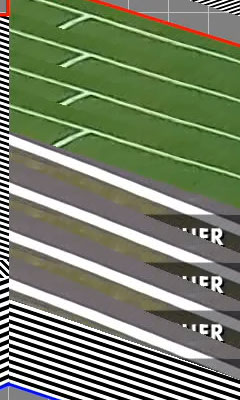
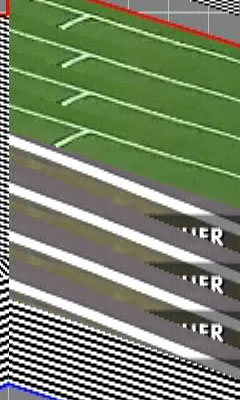
Sports field lines: Non-interlaced on the left, 5450 Deinterlaced on the right
It’s a small edge case, but it’s something that keeps the 5450 from being the perfect HTPC card. Most people should be fine with Motion Adaptive deinterlacing, but if you need perfect AVIVO performance from an AMD card, you’re going to need a Redwood card such as the 5670 at this point in time. This stands as something AMD can improve for videophiles for their next series of low-end cards, similar to how they improved things for audiophiles by adding bitstreaming audio support for the 5000-series.
We also quickly tested NVIDIA’s lower-end cards here to see how they fare. NVIDIA doesn’t offer as many post-processing controls as AMD does, instead leaving it up to the drivers to decide on most things. NVIDIA’s hardware is capable of similar deinterlacing abilities as AMD’s hardware, it just isn’t user-selectable.
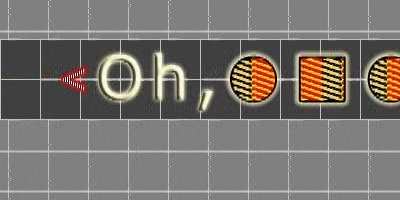
GeForce 210 Deinterlacing
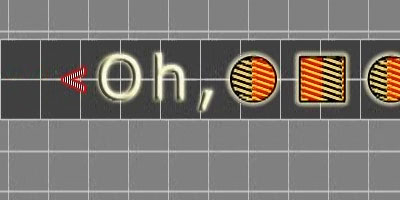
GeForce GT 220 Deinterlacing
The GeForce 210 fares better than the 5450 with Smooth Video Playback here, but it still produces a rough output. Once we move up to the GT220, NVIDIA’s deinterlacer fully catches up and perfectly deinterlaces the angled lines on Cheese Slices.
Finally, if you’d like to see the full 1920x1080 resolution screenshots of our tests, you can get them here.










77 Comments
View All Comments
Lifted - Thursday, February 4, 2010 - link
The first graph on each of the benchmark pages lists a 5670, the second graph lists a 4670. Typo or are you actually using different cards?Ryan Smith - Thursday, February 4, 2010 - link
It's not a typo. We never ran the 5670 at 1024x768, there was no reason to. It's more than fast enough for at least 1280.The 4670 data is from the GT 240 review, which we used 1024 on (because GT 240 couldn't cut the mustard above 1024 at times).
8steve8 - Thursday, February 4, 2010 - link
should have had the clarkdale igp in there for good measure, if you aren't gaming I'd guess that igp would be the way to goMrSpadge - Thursday, February 4, 2010 - link
Would have been interesting to compare idle power consumption: Clarkie + IGP vs. Clarkie + 5450.Ryan Smith - Thursday, February 4, 2010 - link
Testing a Clarkie requires switching out our test rig, so the results wouldn't be directly comparable since it means switching out everything including the processor. Plus Anand we only have a couple of Clarkies, which are currently in use for other projects.At this point Clarkie (and any other IGP) is still less than half as fast as 5450.
strikeback03 - Thursday, February 4, 2010 - link
That brings up the point though that with a card this low on the totem pole it might be nice to include a benchmark or two of it paired with similarly low-priced hardware. I understand the reason for generally using the same testbed, but when it is already borderline playable it would be nice to know that it won't get any slower when actually paired with a cheap processor and motherboard.Ryan Smith - Thursday, February 4, 2010 - link
Testing a Clarkie requires switching out our test rig, so the results wouldn't be directly comparable since it means switching out everything including the processor.At this point Clarkie (and any other IGP) is still less than half as fast as 5450.
kevinqian - Thursday, February 4, 2010 - link
Hey Ryan, I'm glad you are the first reviewer to utilize Blaubart's very helpful deinterlacing benchmark. I would just like to note that with ATI, it seems memory bandwidth plays a big part in deinterlacing method as well. For example, the HD 4650 DDR2 can only perform MA deinterlacing, even tho it has the same shaders as the (VA capable) 4670. The only bottleneck there seems to be the DDR2 memory bandwidth. On the other hand, with the HD 4550, though it has DDR3, it is limited to 64bit memory interface, so that seems to be a limiting factor.I have an old HD 2600Pro DDR2 AGP. When I OC the memory from 800mhz stock to 1000mhz, VA gets activated by CCC and confirmed in Cheese slices.
Nvidia's deinterlacing algorithm seem to be less memory intensive as even the GT220 with DDR2 is able to perform VA-like deinterlacing.
Ryan Smith - Thursday, February 4, 2010 - link
Yeah, I've seen the bandwidth idea thrown around. Unfortunately I don't have any additional suitable low-end cards for testing it.ET - Thursday, February 4, 2010 - link
I think I remember reading that the interpolation of input values in the pixel shader was moved from fixed function units to being done by the shaders.